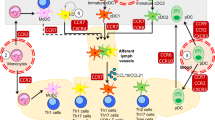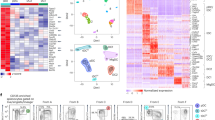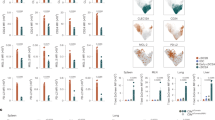Abstract
Dendritic cell (DC) maturation and migration are events critical for the initiation of immune responses. After encountering pathogens, DCs upregulate the expression of costimulatory molecules and subsequently migrate to secondary lymphoid organs. Calcium (Ca2+) entry governs the functions of many hematopoietic cell types, but the role of Ca2+ entry in DC biology remains unclear. Here we report that the Ca2+-activated nonselective cation channel TRPM4 was expressed in and controlled the Ca2+ homeostasis of mouse DCs. The absence of TRPM4, which elicited Ca2+ overload, did not influence DC maturation but did considerably impair chemokine-dependent DC migration. Our results establish TRPM4-regulated Ca2+ homeostasis as crucial for DC mobility but not maturation and emphasize that DC maturation and migration are independently regulated.
This is a preview of subscription content, access via your institution
Access options
Subscribe to this journal
Receive 12 print issues and online access
$209.00 per year
only $17.42 per issue
Buy this article
- Purchase on Springer Link
- Instant access to full article PDF
Prices may be subject to local taxes which are calculated during checkout







Similar content being viewed by others
References
Steinman, R.M., Hawiger, D. & Nussenzweig, M.C. Tolerogenic dendritic cells. Annu. Rev. Immunol. 21, 685–711 (2003).
Bonasio, R. & von Andrian, U.H. Generation, migration and function of circulating dendritic cells. Curr. Opin. Immunol. 18, 503–511 (2006).
Banchereau, J. & Palucka, A.K. Dendritic cells as therapeutic vaccines against cancer. Nat. Rev. Immunol. 5, 296–306 (2005).
Naik, S.H. Demystifying the development of dendritic cell subtypes, a little. Immunol. Cell Biol. 86, 439–452 (2008).
Lewis, R.S. Calcium signaling mechanisms in T lymphocytes. Annu. Rev. Immunol. 19, 497–521 (2001).
Feske, S. Calcium signalling in lymphocyte activation and disease. Nat. Rev. Immunol. 7, 690–702 (2007).
Scharenberg, A.M., Humphries, L.A. & Rawlings, D.J. Calcium signalling and cell-fate choice in B cells. Nat. Rev. Immunol. 7, 778–789 (2007).
Watkins, S.C. & Salter, R.D. Functional connectivity between immune cells mediated by tunneling nanotubules. Immunity 23, 309–318 (2005).
Partida-Sanchez, S. et al. Regulation of dendritic cell trafficking by the ADP-ribosyl cyclase CD38: impact on the development of humoral immunity. Immunity 20, 279–291 (2004).
Hsu, S. et al. Fundamental Ca2+ signaling mechanisms in mouse dendritic cells: CRAC is the major Ca2+ entry pathway. J. Immunol. 166, 6126–6133 (2001).
Scandella, E. et al. CCL19/CCL21-triggered signal transduction and migration of dendritic cells requires prostaglandin E2. Blood 103, 1595–1601 (2004).
Launay, P. et al. TRPM4 is a Ca2+-activated nonselective cation channel mediating cell membrane depolarization. Cell 109, 397–407 (2002).
Nilius, B. et al. Regulation of the Ca2+ sensitivity of the nonselective cation channel TRPM4. J. Biol. Chem. 280, 6423–6433 (2005).
Prawitt, D. et al. TRPM5 is a transient Ca2+-activated cation channel responding to rapid changes in [Ca2+]i . Proc. Natl. Acad. Sci. USA 100, 15166–15171 (2003).
Launay, P. et al. TRPM4 regulates calcium oscillations after T cell activation. Science 306, 1374–1377 (2004).
Vennekens, R. et al. Increased IgE-dependent mast cell activation and anaphylactic responses in mice lacking the calcium-activated nonselective cation channel TRPM4. Nat. Immunol. 8, 312–320 (2007).
Macatonia, S.E., Knight, S.C., Edwards, A.J., Griffiths, S. & Fryer, P. Localization of antigen on lymph node dendritic cells after exposure to the contact sensitizer fluorescein isothiocyanate. Functional and morphological studies. J. Exp. Med. 166, 1654–1667 (1987).
Clapham, D.E. SnapShot: mammalian TRP channels. Cell 129, 220 (2007).
Demion, M., Bois, P., Launay, P. & Guinamard, R. TRPM4, a Ca2+-activated nonselective cation channel in mouse sino-atrial node cells. Cardiovasc. Res. 73, 531–538 (2007).
Floto, R.A. et al. Dendritic cell stimulation by mycobacterial Hsp70 is mediated through CCR5. Science 314, 454–458 (2006).
Sanchez-Sanchez, N. et al. Chemokine receptor CCR7 induces intracellular signaling that inhibits apoptosis of mature dendritic cells. Blood 104, 619–625 (2004).
Pinheiro da Silva, F. et al. CD16 promotes Escherichia coli sepsis through an FcRγ inhibitory pathway that prevents phagocytosis and facilitates inflammation. Nat. Med. 13, 1368–1374 (2007).
Zhang, Y. et al. Coding of sweet, bitter, and umami tastes: different receptor cells sharing similar signaling pathways. Cell 112, 293–301 (2003).
MacAry, P.A. et al. HSP70 peptide binding mutants separate antigen delivery from dendritic cell stimulation. Immunity 20, 95–106 (2004).
Forster, R. et al. CCR7 coordinates the primary immune response by establishing functional microenvironments in secondary lymphoid organs. Cell 99, 23–33 (1999).
Gunn, M.D. et al. Mice lacking expression of secondary lymphoid organ chemokine have defects in lymphocyte homing and dendritic cell localization. J. Exp. Med. 189, 451–460 (1999).
Hubbard, K.B. & Hepler, J.R. Cell signalling diversity of the Gqα family of heterotrimeric G proteins. Cell. Signal. 18, 135–150 (2006).
de Gorter, D.J. et al. Bruton's tyrosine kinase and phospholipase Cγ2 mediate chemokine-controlled B cell migration and homing. Immunity 26, 93–104 (2007).
Heissmeyer, V. et al. Calcineurin imposes T cell unresponsiveness through targeted proteolysis of signaling proteins. Nat. Immunol. 5, 255–265 (2004).
Macian, F., Im, S.H., Garcia-Cozar, F.J. & Rao, A. T-cell anergy. Curr. Opin. Immunol. 16, 209–216 (2004).
Donnadieu, E., Bismuth, G. & Trautmann, A. The intracellular Ca2+ concentration optimal for T cell activation is quite different after ionomycin or CD3 stimulation. Pflugers Arch. 429, 546–554 (1995).
Bhakta, N.R., Oh, D.Y. & Lewis, R.S. Calcium oscillations regulate thymocyte motility during positive selection in the three-dimensional thymic environment. Nat. Immunol. 6, 143–151 (2005).
Randolph, G.J., Ochando, J. & Partida-Sanchez, S. Migration of dendritic cell subsets and their precursors. Annu. Rev. Immunol. 26, 293–316 (2008).
Sanchez-Sanchez, N., Riol-Blanco, L. & Rodriguez-Fernandez, J.L. The multiple personalities of the chemokine receptor CCR7 in dendritic cells. J. Immunol. 176, 5153–5159 (2006).
Ullrich, N.D. et al. Comparison of functional properties of the Ca2+-activated cation channels TRPM4 and TRPM5 from mice. Cell Calcium 37, 267–278 (2005).
Lindquist, R.L. et al. Visualizing dendritic cell networks in vivo. Nat. Immunol. 5, 1243–1250 (2004).
Ohl, L. et al. CCR7 governs skin dendritic cell migration under inflammatory and steady-state conditions. Immunity 21, 279–288 (2004).
Naik, S.H. et al. Intrasplenic steady-state dendritic cell precursors that are distinct from monocytes. Nat. Immunol. 7, 663–671 (2006).
Naik, S.H. et al. Development of plasmacytoid and conventional dendritic cell subtypes from single precursor cells derived in vitro and in vivo. Nat. Immunol. 8, 1217–1226 (2007).
Waskow, C. et al. The receptor tyrosine kinase Flt3 is required for dendritic cell development in peripheral lymphoid tissues. Nat. Immunol. 9, 676–683 (2008).
Mailliard, R.B. et al. α-type-1 polarized dendritic cells: a novel immunization tool with optimized CTL-inducing activity. Cancer Res. 64, 5934–5937 (2004).
Ten Brinke, A., Karsten, M.L., Dieker, M.C., Zwaginga, J.J. & van Ham, S.M. The clinical grade maturation cocktail monophosphoryl lipid A plus IFNγ generates monocyte-derived dendritic cells with the capacity to migrate and induce Th1 polarization. Vaccine 25, 7145–7152 (2007).
Del Prete, A. et al. Regulation of dendritic cell migration and adaptive immune response by leukotriene B4 receptors: a role for LTB4 in up-regulation of CCR7 expression and function. Blood 109, 626–631 (2007).
Acknowledgements
We thank S.Y. Lin (ABgenomics) and B. Koller (University of North Carolina) for help with generation of Trpm4−/−mice; C.S. Zuker (University of California, San Diego) for Trpm5−/− mice; E. Ferrary for help with the patch-clamp setup; M. Benhamou and U. Blank for advice and critical reading of the manuscript; and J. Bex, A. Bouhalfaïa and E. Couchi for help in animal care. Supported by the Association pour la Recherche sur le Cancer (G.B.), Institut National de la Santé et de la Recherche Médicale (M.D. and P.L.), Ministère de l'Enseignement Supérieur et de la Recherche, Université Paris 7 (N.S.), Fondation pour la Recherche Médicale (T.L. and P.L.) and Action Concertée Incitative Jeunes Chercheurs (P.L.).
Author information
Authors and Affiliations
Contributions
G.B. and I.C.M. were responsible for all experiments involving in vivo analysis of Trpm4−/− and Trpm5−/− mice; M.D. did the electrophysiological experiments in the whole-cell configuration; R.G. did the electrophysiological experiments in the 'inside-out' configuration; G.B. and M.D. did Ca2+ imaging; G.B. did the Transwell assays; M.D. did the time-lapse experiments; T.L. contributed to biochemical experiments; N.S. was responsible for quantitative RT-PCR; G.B. and N.S. were responsible for genotyping of mice; J.-P.K. was responsible for the generation of Trpm4−/− mice, critical reading and comments; R.C.M. and F.V. provided experimental guidance; all authors critically reviewed and contributed to the manuscript; and P.L. directed and supervised all aspects of the study and the writing and editing of the manuscript.
Corresponding author
Supplementary information
Supplementary Text and Figures
Supplementary Figures 1–8, Table 1 and Methods (PDF 1219 kb)
Rights and permissions
About this article
Cite this article
Barbet, G., Demion, M., Moura, I. et al. The calcium-activated nonselective cation channel TRPM4 is essential for the migration but not the maturation of dendritic cells. Nat Immunol 9, 1148–1156 (2008). https://doi.org/10.1038/ni.1648
Received:
Accepted:
Published:
Issue Date:
DOI: https://doi.org/10.1038/ni.1648
This article is cited by
-
TRPM channels in health and disease
Nature Reviews Nephrology (2024)
-
TRP channel expression correlates with the epithelial–mesenchymal transition and high-risk endometrial carcinoma
Cellular and Molecular Life Sciences (2022)
-
The circadian clock influences T cell responses to vaccination by regulating dendritic cell antigen processing
Nature Communications (2022)
-
Trpm5 channels encode bistability of spinal motoneurons and ensure motor control of hindlimbs in mice
Nature Communications (2021)
-
New Insights on the Role of TRP Channels in Calcium Signalling and Immunomodulation: Review of Pathways and Implications for Clinical Practice
Clinical Reviews in Allergy & Immunology (2021)



